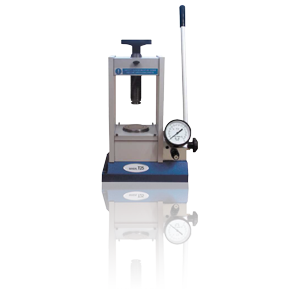Key Uses of a Hydraulic Press
Hydraulics is a technology that leverages the physical properties of fluids to exert mechanical forces in engineering, industrial, scientific and other applications.
Hydraulic presses, in particular, are used in a wide range of industries to assemble, bend, crush, or otherwise alter the shapes of materials. A hydraulic press — also known as a Bramah press — is a machine that uses synthetic, water or petroleum-based fluids to move a cylinder for the purpose of generating a compressive force1. Laboratories use hydraulic presses to prepare samples for analysis.
This blog will outline the principles of operation behind a hydraulic press and present some useful applications.
What is a Hydraulic Press?
A hydraulic press is a machine that uses the pressure generated in a confined fluid to configure metals, plastics, rubber, and other materials2. Its operation is governed by Pascal’s principle, which states that pressure applied to a confined fluid is transmitted unaltered throughout the fluid. In a hydraulic press, this pressure is transmitted to a piston that functions like a pump.
A hydraulic press incorporates a mainframe as well as control and power systems. Hydraulic fluid is forced into a small cylindrical piston (plunger cylinder), which drives the fluid into a larger piston (ram cylinder). As the larger piston moves, it forces the fluid back into the smaller piston. This continuous exchange generates varying degrees of mechanical pressure which is transmitted to an anvil that presses directly on the workpiece to be shaped.
These hydraulic pistons (pumps) can be manually, pneumatically, or electrically operated, depending on the application. They generate a fixed amount of pressure, rated in tons. A basic manual pump can be used for low-force applications, while electric and pneumatic pumps generate larger, consistently applied forces.
Hydraulic presses are used for a variety of applications where materials need to be pressed or separated. They have proven useful due to their ability to apply a substantial compressive force to straighten, bend, stamp, or flatten billets into desired shapes.
Applications of a Hydraulic Press
Hydraulic systems are efficient transmitters of power with relatively few moving parts that are easier to maintain. Hydraulic systems can apply pressures in the region of 10,000 psi compared to about 100 psi for pneumatic systems3.

- Powder compacting: In powder compacting, a hydraulic press compresses powdered materials into various designs and shapes.
- Concrete compression testing: Concrete manufacturers test the tensile strength of their materials using hydraulic presses.
- Scrap baling: Scrap baling equipment is used for crushing metal objects such as cars and machines for easy transport, processing, and storage.
- Ceramics manufacturing: Hydraulic presses that operate at room temperature are replacing high-temperature kiln manufacturing methods for producing ceramic tiles, bricks, and other objects.
- Laboratory testing: Laboratory presses allow manufacturers to test the quality of their products in a laboratory setting.
Sample preparation: Another application of hydraulic presses in a laboratory setting is sample preparation. X-ray fluorescence spectroscopy (XRF) is a non-destructive analytical technique that quantifies fluorescent X-rays emitted from a sample excited by a primary X-ray source. A hydraulic press is used to compress powder mixtures into pellets for XRF analysis. It is a versatile instrument conveying a variety of speeds, directions, and pressures for rapid, high-volume sample preparation.
Hydraulic Presses by XRF Scientific
XRF Scientific supplies a range of manual, power, motorized and automatic presses for XRF sample preparation. The Power Hydraulic Press operates in ranges between 8 and 25 tons. It is microprocessor controlled and loadable in metric and imperial tons for XRF and IR sample preparations.
References
- Sheffield Industrial Museums Trust. Bramah Press. [online] Available at: http://www.simt.co.uk/kelham-island-museum/what-to-see/main-museum-enid-hattersley-gallery/bramah-press
- IQSDirectory.com. Hydraulic Press. [online] Available at: https://www.iqsdirectory.com/articles/hydraulic-press.html
- Henneberry B., What’s the Difference between Hydraulics and Pneumatics? [online] Available at: https://www.thomasnet.com/articles/machinery-tools-supplies/hydraulic-vs-pneumatic-whats-the-difference/









